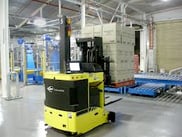As we begin another new year, here’s a post about resolutions. In most organizations there are plans for something new in 2013 – maybe a new product or market, or a new machine or facility. For those of us in the Lean world, new also means re-new – getting better with what we already have. Continuous improvement is great re-newer of the corporate soul, engaging and developing employees while providing greater value to our customers. The best organizations resolve to create greater value and sales growth with very few added resources.
 With the best of intentions however, many organizations make what they think are improvements when they are actually just automating a waste. In an earlier post, for example, I described a high bay automatic storage and retrieval system installed at my company in 1980 to automate our stockroom. In fact, it simply automated the waste of storage while at the same time promoting batch kitting. Fact is, we just had way too much inventory, and the ASRS hid it away from sight. By the time Shigeo Shingo visited my factory in 1989, we had removed the ASRS, and placed inventory back in plain site on the floor. He complemented us on that, but then pointed to my knees and said through an interpreter, “Mr. Materials Manager, don’t be satisfied until the piles of inventory are below your knees. That will be the real improvement.” Shingo was the one to coin the phrase “superficial improvement” to connote automation of a waste in the name of improvement. I think he was pleased at least that we understood the concept of superficial versus real improvement.
With the best of intentions however, many organizations make what they think are improvements when they are actually just automating a waste. In an earlier post, for example, I described a high bay automatic storage and retrieval system installed at my company in 1980 to automate our stockroom. In fact, it simply automated the waste of storage while at the same time promoting batch kitting. Fact is, we just had way too much inventory, and the ASRS hid it away from sight. By the time Shigeo Shingo visited my factory in 1989, we had removed the ASRS, and placed inventory back in plain site on the floor. He complemented us on that, but then pointed to my knees and said through an interpreter, “Mr. Materials Manager, don’t be satisfied until the piles of inventory are below your knees. That will be the real improvement.” Shingo was the one to coin the phrase “superficial improvement” to connote automation of a waste in the name of improvement. I think he was pleased at least that we understood the concept of superficial versus real improvement.
More recently, a large factory in my area installed AGV’s (automatic guided vehicles) to transport materials around a very poorly laid out, functionally organized plant. Shingo would have pointed out to this organization that the parts were traveling just as far on the AGV’s as they had previously on fork lifts, so I made the point for him to the plant manager. The plant manager responded to me incredulously that they had eliminated so many conveyance jobs and now had ‘complaint free conveyance that didn’t charge for overtime.’ As we continued the factory tour (dodging AVG’s) we passed highly automated production processes feeding ultimately into an ASRS that dwarfed the puny six bay unit that had once been in my factory. The manager reported to me that their improvements for the coming year included an expanded ASRS. “A superficial resolution,” I thought to myself. “He’s automated just about every waste from motion to conveyance, and has overproduced to such an extent that he needs more automation to store his finished goods.”
"What are your inventory turns?", I asked the manager. “Marketing owns the inventory” he responded.
So where do you stand with real versus superficial improvements in your organization? Have you resolved to do more in 2013 with the resources you already have, or are your resolutions superficial? Chime in.
Happy New Year
O.L.D.

 With the best of intentions however, many organizations make what they think are improvements when they are actually just automating a waste. In an earlier post, for example, I described a
With the best of intentions however, many organizations make what they think are improvements when they are actually just automating a waste. In an earlier post, for example, I described a